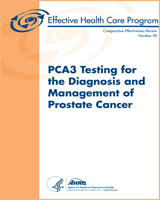NCBI Bookshelf. A service of the National Library of Medicine, National Institutes of Health.
Bradley LA, Palomaki G, Gutman S, et al. PCA3 Testing for the Diagnosis and Management of Prostate Cancer [Internet]. Rockville (MD): Agency for Healthcare Research and Quality (US); 2013 Apr. (Comparative Effectiveness Reviews, No. 98.)
This publication is provided for historical reference only and the information may be out of date.
- Were the sample definition and selection prospective or retrospective?
- Were inclusion/exclusion criteria clearly described?
- Were participants selected to be representative?
- Was there an attempt to balance groups by design?
- Were baseline prognostic characteristics clearly described and groups shown to be comparable?
- Were interventions clearly specified?
- Were participants in treatment groups recruited within the same time period?
- Was there an attempt by investigators to allocate participants to treatment groups in an attempt to minimize bias?
- Were concurrent/concomitant treatments clearly specified and given equally to treatment groups?
- Were outcome measures clearly valid, reliable, and equally applied to treatment groups?
- Were outcome assessors blinded?
- Was the length of followup adequate?
- Was subject attrition below an overall high level (<20 percent)?
- Was the difference in attrition between groups below a high level (<15 percent)?
- Did the analysis of outcome data incorporate a method for handling confounders such as statistical adjustment?
The rating of intervention studies encompassed three quality categories:
- Good studies meet all criteria; comparable groups were assembled initially and maintained throughout the study (followup at least 80 percent); reliable and valid measurement instruments were used and applied equally to the groups; interventions are spelled out clearly; all important outcomes were considered; appropriate attention was given to confounders in analyzing data.
- Fair studies had any or all of the following problems, but without the fatal flaws noted in the “poor” category below; comparable groups were assembled initially, but some questions remain about whether some (although not major) differences occurred with followup; measurement instruments were acceptable (although not the best) and were generally applied equally; some, but not all, important outcomes were considered; some, but not all, potential confounders were accounted for.
- Poor studies have any of the following fatal flaws; groups assembled initially were not close to being comparable or maintained throughout the study; unreliable or invalid measurement instruments were used or not applied at all equally among groups (including not masking outcome assessment); key confounders were given little or no attention.
- Quality Assessment Criteria and Category Definitions for Nonrandomized Comparati...Quality Assessment Criteria and Category Definitions for Nonrandomized Comparative Intervention Studies - PCA3 Testing for the Diagnosis and Management of Prostate Cancer
- Contacted Authors - Local Hepatic Therapies for Metastases to the Liver From Unr...Contacted Authors - Local Hepatic Therapies for Metastases to the Liver From Unresectable Colorectal Cancer
- DistillerSR Abstract and Title Screening Form - PCA3 Testing for the Diagnosis a...DistillerSR Abstract and Title Screening Form - PCA3 Testing for the Diagnosis and Management of Prostate Cancer
- dickkopf-related protein 3 isoform b precursor [Mus musculus]dickkopf-related protein 3 isoform b precursor [Mus musculus]gi|1336503530|ref|NP_001347189.1|Protein
- Future Research Needs for Comparative Effectiveness of Treatments of Localized P...Future Research Needs for Comparative Effectiveness of Treatments of Localized Prostate Cancer
Your browsing activity is empty.
Activity recording is turned off.
See more...
